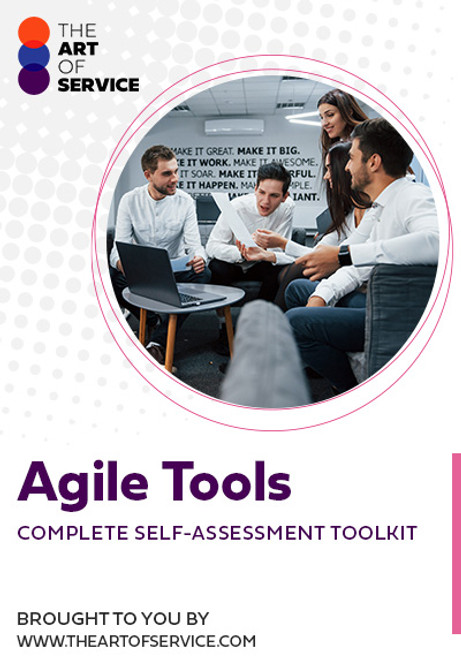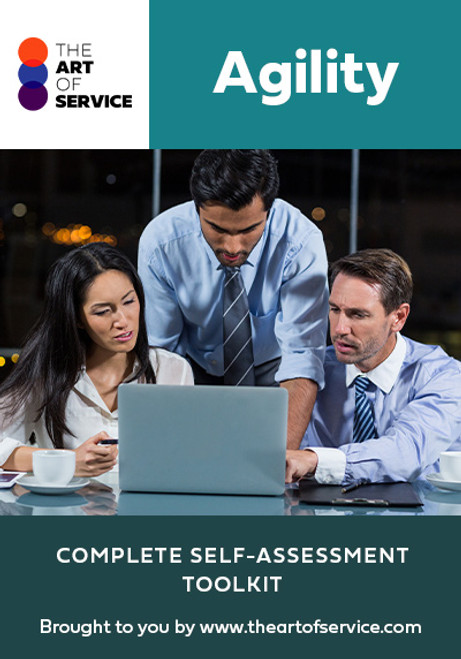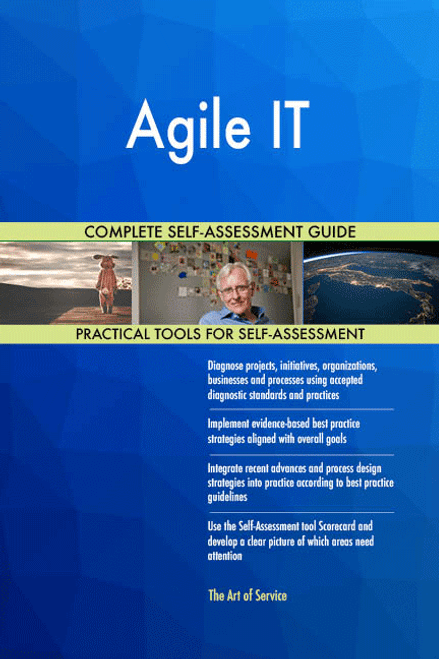Systematize Agile Tooling: Data Management, manipulation, and aggregation (relational databases, Web Services, big data).
More Uses of the Agile Tooling Toolkit:
- Collaborate with software Quality Assurance and Development Teams in an Agile environment using Business Requirements, and design artifacts, acting as the Voice of the customer.
- Make sure that your corporation creates structure, organizational processes based on iterative development models and Continuous Delivery to drive outcomes and value of Agile delivery teams.
- Ensure you standardize; understand and can adapt processes associated to regulated Software Development (from traditional development methodology to Agile methodology).
- Drive innovation with LOB stakeholders during Agile Development sessions to create and improve dashboards leveraging newly on boarded data sources.
- Collaborate with cross functional Agile and Scrum Engineering teams to develop cost controlling mechanisms for project releases and portfolio planning.
- Ensure you facilitate; build holistic view of enterprise Cloud Strategy, processes, information, technology to enable your business and customers to take advantage of advanced capabilities in the cloud in an agile and sustainable manner.
- Create a team managing Agile Management tools and techniques.
- Guide Agile Tooling: expert Technical Engineering resource to Agile team in the report development, testing, and implementation process.
- Develop Agile Tooling: Agile it is your organization built around the cloud and offers a variety of Cloud Solutions for your customers.
- Support the Agile Software Development process among cross functional teams to ensure smooth product delivery.
- Be accountable for managing software functional requirements throughout the SDLC Participation in an Agile software Development Environment.
- Orchestrate Agile Tooling: work in safe Agile environment to develop an Api Gateway.
- Be accountable for developing automation process like repository backup, restart/reboot the server and connection / user Privilege Management in Agile SDLC methodology.
- Orchestrate Agile Tooling: by working in an Agile manner, e and c ensures the balance between stable structures, governance, Processes And Systems, and dynamic approaches to delivering innovative solutions to appropriately manage your risks.
- Investigate reported problems to uncover root cause, serve as a technical resource for one or more Agile teams.
- Employ rigorous Continuous Delivery practices managed under an Agile Software Development approach.
- Ensure you join; understand and provide consulting on Agile Project Management framework as Scrum and Kanban and Agile Software Engineering practices.
- Ensure primary responsibility is to work with Developers, Agile Software Testers, Verification Leads, Product Owner and Project Management to meet the sprint and release goals.
- Gather, analyze and document Business Requirements, Process Flows, and transfer knowledge to the development team with Agile environments.
- Ensure you chart; aid technology domains in driving Operational Excellence through organization of Agile processes and technologies to drive quick provisioning, accurate configurations, repeatable processes/implementations.
- Ensure your corporation provides Scaled Agile Framework (safe) coaching and training at the team, program, and enterprise level to effectively implement the Agile Development approach.
- Establish that your organization coordinates test environment setup for all planned test execution activities and uses Software Testing types and methods to support Agile Development.
- Ensure your organization provides Scaled Agile Framework (safe) coaching and training at the team, program, and enterprise level to effectively implement the Agile Development approach.
- Assure your strategy facilitates Organizational Learning, Change Management, and process adoption of Agile via metrics, Benefits Realization, outcomes, and retrospective findings.
- Use Agile Software Development practices to rapidly build a working application using modern technologies.
- Make sure that your business coordinates test environment setup for all planned test execution activities and uses Software Testing types and methods to support Agile Development.
- Collaborate and contribute in international, multi site development in an Agile environment.
- Be accountable for writing Test Scripts in an Agile software Development Environment with an emphasis on Automated Test procedures.
- Initiate Agile Tooling: partner with other Product Managers/owners, Agile managers and leadership to mature the offering and ensure it exceeds the expectations of your customers and users.
- Ensure your organization delivers productivity to customers through Materials Science, tooling and wear resistant solutions.
- Ensure you transform; lead Process Improvement identifying and acting upon ways to improve internal Systems And Processes referring ideas to the appropriate Line Management.
Save time, empower your teams and effectively upgrade your processes with access to this practical Agile Tooling Toolkit and guide. Address common challenges with best-practice templates, step-by-step Work Plans and maturity diagnostics for any Agile Tooling related project.
Download the Toolkit and in Three Steps you will be guided from idea to implementation results.
The Toolkit contains the following practical and powerful enablers with new and updated Agile Tooling specific requirements:
STEP 1: Get your bearings
Start with...
- The latest quick edition of the Agile Tooling Self Assessment book in PDF containing 49 requirements to perform a quickscan, get an overview and share with stakeholders.
Organized in a Data Driven improvement cycle RDMAICS (Recognize, Define, Measure, Analyze, Improve, Control and Sustain), check the…
- Example pre-filled Self-Assessment Excel Dashboard to get familiar with results generation
Then find your goals...
STEP 2: Set concrete goals, tasks, dates and numbers you can track
Featuring 999 new and updated case-based questions, organized into seven core areas of Process Design, this Self-Assessment will help you identify areas in which Agile Tooling improvements can be made.
Examples; 10 of the 999 standard requirements:
- How do you maintain Agile Tooling's Integrity?
- Where is training needed?
- How do you verify the Agile Tooling requirements quality?
- Who is the main stakeholder, with ultimate responsibility for driving Agile Tooling forward?
- Which stakeholder characteristics are analyzed?
- How do you engage the workforce, in addition to satisfying them?
- Who will gather what data?
- What is it like to work for you?
- Are controls defined to recognize and contain problems?
- What role does communication play in the success or failure of a Agile Tooling project?
Complete the self assessment, on your own or with a team in a workshop setting. Use the workbook together with the self assessment requirements spreadsheet:
- The workbook is the latest in-depth complete edition of the Agile Tooling book in PDF containing 994 requirements, which criteria correspond to the criteria in...
Your Agile Tooling self-assessment dashboard which gives you your dynamically prioritized projects-ready tool and shows your organization exactly what to do next:
- The Self-Assessment Excel Dashboard; with the Agile Tooling Self-Assessment and Scorecard you will develop a clear picture of which Agile Tooling areas need attention, which requirements you should focus on and who will be responsible for them:
- Shows your organization instant insight in areas for improvement: Auto generates reports, radar chart for maturity assessment, insights per process and participant and bespoke, ready to use, RACI Matrix
- Gives you a professional Dashboard to guide and perform a thorough Agile Tooling Self-Assessment
- Is secure: Ensures offline Data Protection of your Self-Assessment results
- Dynamically prioritized projects-ready RACI Matrix shows your organization exactly what to do next:
STEP 3: Implement, Track, follow up and revise strategy
The outcomes of STEP 2, the self assessment, are the inputs for STEP 3; Start and manage Agile Tooling projects with the 62 implementation resources:
- 62 step-by-step Agile Tooling Project Management Form Templates covering over 1500 Agile Tooling project requirements and success criteria:
Examples; 10 of the check box criteria:
- Cost Management Plan: Eac -estimate at completion, what is the total job expected to cost?
- Activity Cost Estimates: In which phase of the Acquisition Process cycle does source qualifications reside?
- Project Scope Statement: Will all Agile Tooling project issues be unconditionally tracked through the Issue Resolution process?
- Closing Process Group: Did the Agile Tooling Project Team have enough people to execute the Agile Tooling Project Plan?
- Source Selection Criteria: What are the guidelines regarding award without considerations?
- Scope Management Plan: Are Corrective Actions taken when actual results are substantially different from detailed Agile Tooling Project Plan (variances)?
- Initiating Process Group: During which stage of Risk planning are risks prioritized based on probability and impact?
- Cost Management Plan: Is your organization certified as a supplier, wholesaler, regular dealer, or manufacturer of corresponding products/supplies?
- Procurement Audit: Was a formal review of tenders received undertaken?
- Activity Cost Estimates: What procedures are put in place regarding bidding and cost comparisons, if any?
Step-by-step and complete Agile Tooling Project Management Forms and Templates including check box criteria and templates.
1.0 Initiating Process Group:
- 1.1 Agile Tooling project Charter
- 1.2 Stakeholder Register
- 1.3 Stakeholder Analysis Matrix
2.0 Planning Process Group:
- 2.1 Agile Tooling Project Management Plan
- 2.2 Scope Management Plan
- 2.3 Requirements Management Plan
- 2.4 Requirements Documentation
- 2.5 Requirements Traceability Matrix
- 2.6 Agile Tooling project Scope Statement
- 2.7 Assumption and Constraint Log
- 2.8 Work Breakdown Structure
- 2.9 WBS Dictionary
- 2.10 Schedule Management Plan
- 2.11 Activity List
- 2.12 Activity Attributes
- 2.13 Milestone List
- 2.14 Network Diagram
- 2.15 Activity Resource Requirements
- 2.16 Resource Breakdown Structure
- 2.17 Activity Duration Estimates
- 2.18 Duration Estimating Worksheet
- 2.19 Agile Tooling project Schedule
- 2.20 Cost Management Plan
- 2.21 Activity Cost Estimates
- 2.22 Cost Estimating Worksheet
- 2.23 Cost Baseline
- 2.24 Quality Management Plan
- 2.25 Quality Metrics
- 2.26 Process Improvement Plan
- 2.27 Responsibility Assignment Matrix
- 2.28 Roles and Responsibilities
- 2.29 Human Resource Management Plan
- 2.30 Communications Management Plan
- 2.31 Risk Management Plan
- 2.32 Risk Register
- 2.33 Probability and Impact Assessment
- 2.34 Probability and Impact Matrix
- 2.35 Risk Data Sheet
- 2.36 Procurement Management Plan
- 2.37 Source Selection Criteria
- 2.38 Stakeholder Management Plan
- 2.39 Change Management Plan
3.0 Executing Process Group:
- 3.1 Team Member Status Report
- 3.2 Change Request
- 3.3 Change Log
- 3.4 Decision Log
- 3.5 Quality Audit
- 3.6 Team Directory
- 3.7 Team Operating Agreement
- 3.8 Team Performance Assessment
- 3.9 Team Member Performance Assessment
- 3.10 Issue Log
4.0 Monitoring and Controlling Process Group:
- 4.1 Agile Tooling project Performance Report
- 4.2 Variance Analysis
- 4.3 Earned Value Status
- 4.4 Risk Audit
- 4.5 Contractor Status Report
- 4.6 Formal Acceptance
5.0 Closing Process Group:
- 5.1 Procurement Audit
- 5.2 Contract Close-Out
- 5.3 Agile Tooling project or Phase Close-Out
- 5.4 Lessons Learned
Results
With this Three Step process you will have all the tools you need for any Agile Tooling project with this in-depth Agile Tooling Toolkit.
In using the Toolkit you will be better able to:
- Diagnose Agile Tooling projects, initiatives, organizations, businesses and processes using accepted diagnostic standards and practices
- Implement evidence-based Best Practice strategies aligned with overall goals
- Integrate recent advances in Agile Tooling and put Process Design strategies into practice according to Best Practice guidelines
Defining, designing, creating, and implementing a process to solve a business challenge or meet a business objective is the most valuable role; In EVERY company, organization and department.
Unless you are talking a one-time, single-use project within a business, there should be a process. Whether that process is managed and implemented by humans, AI, or a combination of the two, it needs to be designed by someone with a complex enough perspective to ask the right questions. Someone capable of asking the right questions and step back and say, 'What are we really trying to accomplish here? And is there a different way to look at it?'
This Toolkit empowers people to do just that - whether their title is entrepreneur, manager, consultant, (Vice-)President, CxO etc... - they are the people who rule the future. They are the person who asks the right questions to make Agile Tooling investments work better.
This Agile Tooling All-Inclusive Toolkit enables You to be that person.
Includes lifetime updates
Every self assessment comes with Lifetime Updates and Lifetime Free Updated Books. Lifetime Updates is an industry-first feature which allows you to receive verified self assessment updates, ensuring you always have the most accurate information at your fingertips.







